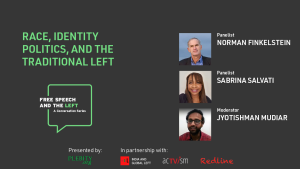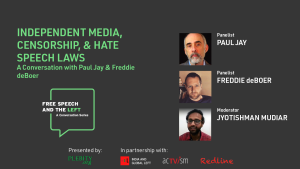March 2, 2021 – Update
A couple days ago, a heated exchange erupted on Twitter on the merits of Substack. Dr. Sarah T. Roberts, a UCLA professor, wrote several Twitter threads critiquing Substack, calling it the “Influencer Model.” Of her many arguments, Roberts critiques the notion that Silicon Valley titans can rescue journalism and counteract the prevailing force of corporate media.
It’s always best practice to refrain from engaging in Twitter battles. Nobody wins, and everyone looks worse for it. This one is no different. But, because of the nature of the topic, a conversation must be had – however difficult – on the role of Substack in journalism today. No matter what one’s opinion is on the topic, Roberts was right to bring it up (and she certainly wasn’t the first one to do so).
Unfortunately, any potential conversation was cut short. The merciless Twittersphere found her. Insults were hurled. Threats made. Personal attacks thrown. Even worse, Roberts’ tweets were selectively picked, some ignored – others magnified to the point of distortion. It was a Typical Twitter Response: a disproportionate reaction emerging out of someone expressing a personal opinion.
Roberts soon got the attention of Matt Taibbi, who later wrote a Substack post aptly titled “In Defense Of Substack,” in which he extrapolates (and in some ways, distorts) a single thread of Roberts’ argument and uses it as a back-drop to critique traditional media. The article is well-written, thorough – the usual for Taibbi. Roberts, too, makes good points on the role of tech in journalism.
At the risk of sounding both sides-ist, I’m not interested in re-hashing this ‘he-said, she-said’ exchange or adding to the pile-on. I am interested in the (over)reaction to Roberts’ tweets and what it says about the state of discourse today – as well as our inclination to view every up-and-coming platform as the Next Best Thing, including Substack.
As I point out in my original article, Taibbi’s post is an example of how filter bubbles emerge and how they distort reality and inadvertently limit readers’ perspectives. Despite Roberts clarifying her argument, tweeting “the state of corporate media is a disgrace,” commenters still condemned her for being a corporate shill, without bothering to seek out her other tweets that offered more context than what Taibbi showed.
While traditional media has its own issues, subscription-based models are more focused on the persona, rather than the publication, which can cause its own set of problems. High-profile writers like Taibbi have a more devoted and loyal fan base than a less seasoned journalist. Loyal followers are always desired from a writer’s perspective, but followers can also be fanatical. As it stands, Taibbi’s comments section for his Defense Of Substack post looks more like a rogue Twitter thread than an open, reasoned discussion. It is rife with groupthink and idolatry – a dangerous path for anyone who wants to preserve their critical thinking skills. His followers are quick to hurl personal attacks at Roberts, deepening the fissures between them and her, a tactic that does nothing more than foment animosity. On Substack, writers are shielded even more by their devoted followers, creating a more insular space in which dissenting opinion is dangerously lacking.
Traditional media should be disrupted, though I question whether Substack is the solution. While Substack is not on the level of Facebook or Twitter, it is still a tech company – a for-profit, venture capital-backed company that is running on the fuel of hype. Unpopular opinion or not, this should still be discussed. Often there is this knee-jerk tendency, particularly among technologists and techno-utopians, to view any platform or device as revolutionary or democratizing. Substack was given the same treatment. I, too, had high hopes for it when I first commented on Glenn Greenwald’s departure from The Intercept to Substack. But that doesn’t mean Substack should be immune to all present or future criticism (and that people criticizing it should be immediately assumed to be corporate shills or MSM-advocates).
Substack is a departure from traditional media – and that is precisely what makes it so appealing. Writers on the platform are free from rigid editorial and creative control. They hold the reins. A space for “independent writers”, Substack lives up to expectation in some ways, but in others, the jury’s still out. As it stands there are media companies already on Substack, and I suspect more to come. If previous platforms are any indication (see: Medium), then Substack may run the risk of turning into another space roomy enough for high-profile writers only, but snug enough that lesser-known independent voices are turned away, or they’re drowned out completely.
One can be both critical of Substack and corporate media. One can also use Substack while being aware of its limitations. Roberts’ structural critique about Substack deserves more attention. And Taibbi’s incisive commentary about the corrupt corporate media is also deserving of a read. However, as it stands, the latter is a less controversial opinion than the former. And that’s precisely why Roberts’ argument deserves more attention at this time.
If nothing else, this heated exchange shows how desperately we need open and respectful conversations with people we disagree with, especially on issues like this.
At the launch of Substack in 2017, co-founders Chris Best and Hamish McKenzie penned an essay declaring “the great journalistic totems of the last century are dying.” It’s a fair declaration to make: news outlets are sunsetting at alarming rates; more journalists are getting furloughed or laid off every day; mis- and dis-information is on the rise; and ‘junk food’ content is the preferred meal of choice. Even with these trends, the establishment class continues to occupy much of the media landscape – their voices echo across the ornate halls of legacy media and new media, much to the chagrin of many.
The Mass Migration
Over the past several months, many of these reputable voices – including high-profile journalists – have been jumping ship from their safe, cushy jobs to join Substack, a newsletter-based subscription platform, to escape the onslaught of ideology, censorship, and rigid editorial control.
Some are calling this migration the “beginning of the gold rush,” others are comparing Substack to the old Internet, while others are likening it to the early newsletters of the 17th century. In some ways, Substack does harken back to the old blogosphere; it is reminiscent of a former Internet, and elicits a certain sense of nostalgia. As tempting as it is to see this as a step towards building a rich information ecosystem, I fear this mass migration will simply re-organize the establishment class in new ways and create more toll booths on the information highway.
Personality Over Publication
While Substack is free from ads, its subscription-based model is not free from problems. The platform disproportionately benefits writers who have already amassed a large following through their previous positions writing for legacy media.
For example, Bari Weiss, a former writer for The New York Times and The Wall Street Journal, benefited greatly from traditional media. In early January 2021, Weiss fled the ‘old guardrails’ of The New York Times to start a Substack newsletter. In her first post, Weiss writes, this is a period of “unraveling of the old political consensus, the old order, the old conventions, the old guardrails, the old principles, the old shared stories, the old common identity.” Ironically, Weiss includes herself among the list of those who sees themselves as resisting the ‘professional class’ despite being well-established herself.
Weiss, like other establishment-turned-independent voices, including Andrew Sullivan and Matt Taibbi, don’t just hit reset once they join Substack – they bring over their existing following, connections, and influence to this new space with them, giving them a leg up over emerging, independent writers. And in today’s age of information saturation, building up a following from scratch with no prior experience is an especially arduous feat. Already, the gentrification of Substack may well be underway, where less seasoned voices may have to work harder to build their following than these high-profile commentators.
On top of this, because more people today are turning to individual creators rather than large media publications for their news, this puts more pressure on non-established writers to build their own personal brand to compete with these high-profile voices. Co-founder Chris Best confirms that Substack is more about personality than publication. The goal, Best says, is “to allow writers and creators to run their own personal media empire.” The direction towards building a ‘personal media empire’ may also foment blind idolatry of public figures, and put more focus on the personality than the story.
For the Taibbi’s and the Weiss’s of the world, this isn’t a barrier for entry. But for everyone else, this may be an additional challenge. Many emerging writers may lack the resources and time needed to grow their personal brand on top of producing regular content.
Medium: A Cautionary Tale
Substack as a concept isn’t new. Medium, a blogging platform launched 5 years before Substack, also hoped to democratize blogging. In its early days, novice writers were attracted to Medium’s ad-free model and clean interface. At the time, it was an exciting new space for writers to focus only on the writing and not have to worry about SEO, web development, or any of the other skills typically required to maintain a blog.
Medium went to great lengths to recruit established writers and editors from other media outlets to create and manage its in-house publications. Now it has turned into another gentrified platform where high-profile writers disproportionately receive the most attention, while everyone else is forced to compete with these public personalities for views. There’s a reason why derivative articles like ‘How I Went Viral on Medium’ or ‘How to Make Money on Medium’ consistently float to the top of most-viewed lists. While some independent bloggers do make money, as it stands, Medium is viewed as a semi-failed, unprofitable, endless thought experiment that has not democratized writing, but has turned it into another space for affluent voices (and clickbait articles) to crowd out all the others.
In some respects, Substack looks to be the latest attempt to ‘democratize writing’ as Medium once tried to do. Since its inception, Substack branded itself as a “place for independent writing” where writers can make money off of their subscriptions: writers can control which posts can be publicly viewable for free, and which ones are paywalled. The platform is everything an independent writer could want: all publishers are free from the rigid constraints of editorial, advertising, and creative control that comes with traditional publishing. Seen as a neutral online platform, one can see how it might be the solution to escape external influence, but if Medium is any indication, we should remain cautious before calling Substack a ‘newsletter revolution.’
Newspapers, The True Equalizers
While newspapers are a physical embodiment of the ‘old guard,’ in many ways they are a democratizing force in themselves. The ‘penny paper’ – a tabloid-style newspaper produced in the US in the 1830s, revolutionized the industry by incorporating mass advertising into its model, making the news affordable and accessible to everyone. Prior to the penny paper, newspapers were considered a luxury because of their cost; they were mostly read by the upper class who could afford the six cent price tag. While there is a temptation to disparage all forms of legacy media – including newspapers – in many ways, it continues to be the most accessible form of media today. Many print and digital papers remain free, while others cost less than a Substack subscription. On the other hand, the newsletter-subscription model requires readers to subscribe (and sometimes pay) to many different writers, creating more competition on the writers’ side to fight for readers’ already limited attention span. And while Substack subscriptions range from $5 to $50 a month, costs quickly add up if readers want to support more than a couple creators – and I suspect very few people would be willing to pay for multiple subscriptions, and even fewer would be able to afford it.
Additionally, because Substack is newsletter-based, readers may be inadvertently putting themselves in more filter bubbles, where they run the risk of being exposed to limited perspectives and opinions that confirm their existing beliefs. In contrast, in newspapers and newsrooms, readers are typically exposed to a wider range of voices and opinions. These traditional outlets – despite all of their issues – offer readers the opportunity to discover new voices all in one place.
Low Functionality, High Financial Incentives
Another thing that separates Substack from earlier blogging platforms is its limited functionality. Substack newsletters are near impossible to find without an external referral or recommendation (though its founders acknowledge this may change in the future). Many readers come from other major platforms, so independent writers are just as beholden to the same rules of self-promotion as traditional media outlets.
Substack also provides incentives for high-profile writers to recruit them to the platform, including health care stipends, design help, and even money to hire freelance editors. Substack writers can apply for access to a legal defense fund, which covers up to a million dollars in legal fees, depending on the case. Substack has also paid six-figure advances to entice writers to the platform. On top of offering incentives, Substack has donated $100,000 in grants to its writers who have experienced economic hardship due to the pandemic. So far, it’s paying off: Substack’s readership and writership doubled during the first three months of the pandemic – and its popularity continues to soar.
While many of these established voices have been lauded for their courage to move to these platforms – their move towards independence doesn’t necessarily mean financial or reputational risk. For example, the top ten publishers collectively bring in $7 million in annual revenue. Bari Weiss is only six weeks into her newsletter and she’s already making more than she did at the Times. On top of having independent writers, there are already full-fledged companies on the platform, like The Bulwark and The Dispatch – another indicator that established voices are already winning out.
Established Voices Prevail
Many other platforms tried to elevate independent voices in their own way, whether through video, like YouTube, or through the written word, like Medium. Unfortunately, over time, they have succumbed to prioritizing corporatized content and established voices over emerging creators. These platforms, sold as alternatives to traditional media, now primarily cater to affluent voices, with every iterative platform looking more like the one before it.
It’s evident: high-profile writers are already getting special treatment, proving that this is not a resurgence of the traditional blogosphere in which all creators are treated evenly, but rather another case of a popularity contest run amuck. Substack doesn’t represent a divergence from the ‘old order’ as Bari Weiss writes, the powers-that-be have simply been re-assembled in new ways, and the new order already looks a lot like the old.
–Rozali Telbis



